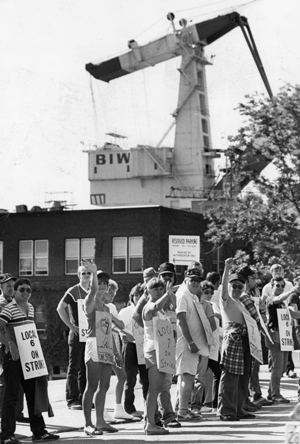Maine’s proficient, hardworking, and regionally low-paid laborers helped to secure a competitive edge in the shipbuilding industry of the 19th century, contributing to the state’s significance as a center of American shipbuilding and fleet ownership.
Like many historic narratives, this shipbuilding prominence has often been examined through the lens of prominent entrepreneurs. But without a workforce, the achievements of these men would not have been possible.
Generations of Maine shipbuilders have developed and honed skills amid war, economic shifts, and technological advances. This legacy is alive and well in Maine today, particularly in Bath—a city that has continuously built ships on the banks of the Kennebec River since the 1780s.
Bath Iron Works (BIW) is Bath’s last remaining shipyard. Formerly a builder of a variety of vessel types such as yachts, freighters, passenger steamers, and railroad ferries, it has been in business since 1884 and has built exclusively for the U.S. Navy for over 30 years.
As an employer of 6,500, BIW’s contributions to the local economy are immense. Over 4,000 of these employees work in the trades and make up the membership of the Local S6 Chapter of the International Association of Machinists and Aerospace Workers. This labor union just voted in August to accept a new three-year contract among which minimum pay rates and benefits are negotiated along with other provisions.
In 2020, similar contract negotiations with union membership failed, with workers voting to reject terms and go on strike. This has happened only a handful of times since BIW trades have been represented by a single union in the early 1950s.

The duration of these strikes has ranged from less than a week to over three months. The image pictured here was taken in the summer of 1985, during BIW’s longest Local S6 strike to date—99 days. Those in the picket line stand across the street from the union hall and at the edge of a parking lot that has seen little change since. Such scenes have been rarely documented throughout the history of labor disputes in Maine’s shipyards.
The fact that BIW’s longest strike occurred in the 1980s is not surprising given the national climate of tensions between businesses and unions. The Reagan White House had openly supported the swift firing, and lifetime employment ban, of a group of specialized government employees on strike.
Private sector employers were emboldened to stand up to their own union-backed workforces, portraying them as selfish and impediments to economic growth. With weakened leverage, union membership declined.
Along with trickle-down economic policies of the era, this series of events has been linked to decades-long income-gap widening and wage stagnation. For comparison, the national union membership rates of 40 years ago were double today’s 10%.
The fact that Bath Iron Works employs Mainers from all 16 counties certainly says something about the attraction, and importance, of stable wages that a union can help to maintain.
Bath has had a lengthy history with organized labor in its shipyards. As far back as 1841, there is evidence of a movement to reduce workdays to ten hours via a group that was aptly named the Bath 10 Hour Association. They were specifically opposed to the practice of a year-round, sun-up to sundown workday that neared 15 hours per day in the summer.
By 1850 this reduced schedule was a common practice throughout the city’s 20 shipyards, and adjacent shipbuilding communities followed suit. This was decades ahead of Progressive Era and Great Depression policies. Eventually, federal legislation established a 40-hour week with overages eligible for overtime pay after 1940.
Kelly Page is collections and library services manager for Maine Maritime Museum in Bath. Explore resources and plan your visit at www.MaineMaritimeMuseum.org.





